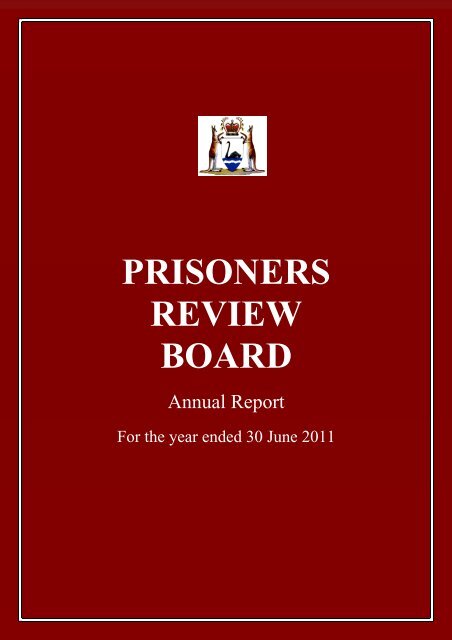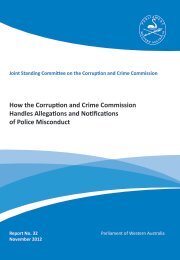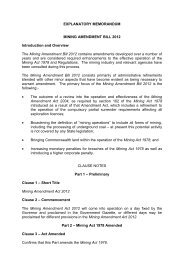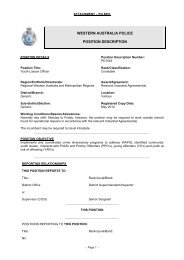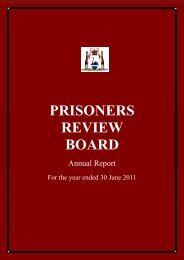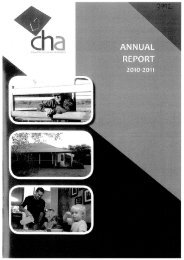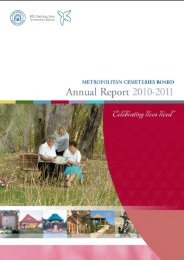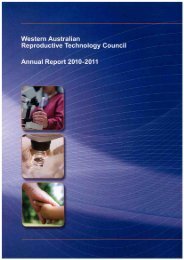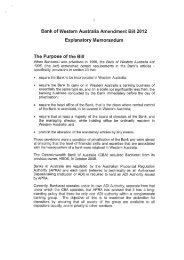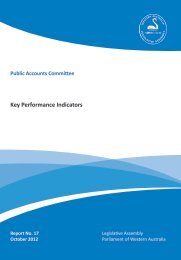PRISONERS REVIEW BOARD - Parliament of Western Australia
PRISONERS REVIEW BOARD - Parliament of Western Australia
PRISONERS REVIEW BOARD - Parliament of Western Australia
You also want an ePaper? Increase the reach of your titles
YUMPU automatically turns print PDFs into web optimized ePapers that Google loves.
<strong>PRISONERS</strong><br />
<strong>REVIEW</strong><br />
<strong>BOARD</strong><br />
Annual Report<br />
For the year ended 30 June 2011
<strong>PRISONERS</strong> <strong>REVIEW</strong> <strong>BOARD</strong><br />
Foreword,<br />
To Attorney General Christian Porter, MLA<br />
In accordance with section 112 <strong>of</strong> the Sentence<br />
Administration Act 2003, I present to you the Annual<br />
Report <strong>of</strong> the Prisoners Review Board <strong>of</strong> <strong>Western</strong><br />
<strong>Australia</strong> for the year ended 30 June 2011.<br />
Justice Narelle Johnson<br />
Chairman<br />
Prisoners Review Board<br />
23 September 2011<br />
__________________________________________<br />
In line with State Government requirements, the<br />
Prisoners Review Board annual report is published in<br />
an electronic format with limited use <strong>of</strong> graphics and<br />
illustrations to help minimise download times.<br />
_________________________________________<br />
ii
<strong>PRISONERS</strong> <strong>REVIEW</strong> <strong>BOARD</strong><br />
CONTENTS<br />
Foreword<br />
Contents<br />
ii<br />
iii<br />
The Prisoners Review Board 1<br />
Message from the Chairperson 2<br />
The Function <strong>of</strong> the Board 6<br />
Statistical Requirements under 9<br />
Section 112 <strong>of</strong> the Sentence Administration Act 2003<br />
iii
<strong>PRISONERS</strong> <strong>REVIEW</strong> <strong>BOARD</strong><br />
The Prisoners Review Board<br />
(The Board)<br />
Supreme Court Justice Narelle Johnson was appointed as Chairperson by the<br />
Attorney General, Mr Christian Porter in March 2009.<br />
The Prisoners Review Board comprises the Chairperson, four Deputy<br />
Chairpersons and seven sessional Community Members. The Board meets<br />
at least six times a week and every meeting will consider about nine<br />
applications for parole and two or three reports <strong>of</strong> breaches <strong>of</strong> parole. Each<br />
meeting is chaired by either the Chairperson or a Deputy Chairperson and<br />
includes two Community Members, a Department <strong>of</strong> Corrective Services<br />
representative and a representative from the WA Police.<br />
To achieve continuous improvement <strong>of</strong> the functions <strong>of</strong> the Board each<br />
member is required to participate in the pr<strong>of</strong>essional development<br />
programme. This is designed to ensure a thorough understanding <strong>of</strong> the<br />
Sentence Administration Act 2003 and the latest national and international<br />
research about community and prison services that minimise the risk <strong>of</strong> a<br />
prisoner re <strong>of</strong>fending and enhance the safety <strong>of</strong> the community.<br />
The combination <strong>of</strong> careful recruitment to embrace the benefits <strong>of</strong> a skilled<br />
and diverse workforce coupled with the objective <strong>of</strong> making informed, well<br />
reasoned decisions about release on parole means the Board is delivering a<br />
high standard service focussed on; “The degree <strong>of</strong> risk that the release <strong>of</strong> the<br />
prisoner would appear to present to the personal safety <strong>of</strong> people in the<br />
community or <strong>of</strong> any individual in the community”. S5A Sentence<br />
Administration Act 2003<br />
1
<strong>PRISONERS</strong> <strong>REVIEW</strong> <strong>BOARD</strong><br />
MESSAGE FROM THE CHAIRPERSON<br />
In the previous Annual Report I emphasised the lack <strong>of</strong> knowledge in the<br />
community <strong>of</strong> the basic principles <strong>of</strong> parole and the legislative framework<br />
which applies.<br />
For this report I propose to focus on the developments which have taken<br />
place in relation to the Board itself. As Chairperson I have always emphasised<br />
the importance <strong>of</strong> attracting members and deputies <strong>of</strong> the highest calibre and<br />
<strong>of</strong> ensuring that the administrative support provided to the Board is <strong>of</strong> the<br />
highest standard. Together with appropriate training, this combination <strong>of</strong><br />
factors increases the standard <strong>of</strong> the decisions made and results in greater<br />
consistency.<br />
Deputy Chairperson, Christine Kannis, has now been joined by three more<br />
Deputy Chairpersons, Catherine Harvey, Stephanie Brakespeare and Barbara<br />
Hostalek. Together with the Registrar and the Executive Manager, they form<br />
the Board Executive which assists in the determination <strong>of</strong> procedure and<br />
policy and, most importantly, with future planning. The Board is committed to<br />
a process <strong>of</strong> continuous improvement and the Executive is constantly<br />
scrutinising the work <strong>of</strong> the Board and identifying areas in which gains can be<br />
made.<br />
There have also been significant changes to the community membership <strong>of</strong><br />
the Board since the beginning <strong>of</strong> this calendar year. The emphasis on<br />
pr<strong>of</strong>essional development resulted in a decision to require all new members,<br />
including the new Deputy Chairpersons, to undergo a week long training<br />
programme before taking up their positions. The representatives from the<br />
Department <strong>of</strong> Corrective Services and the Police Service, who have<br />
commenced at different times, were all required to undergo training sessions<br />
before being permitted to make parole decisions. This has ensured that every<br />
member has the capacity to make a strong contribution to the decision making<br />
<strong>of</strong> the Board from the outset.<br />
Pr<strong>of</strong>essional development sessions are compulsory for all members. They are<br />
held more regularly than in the past and the focus has been on information<br />
directly related to the work <strong>of</strong> the Board. Lectures on treatment programmes,<br />
on urinalysis and on psychological issues relating to sex <strong>of</strong>fenders are just<br />
some <strong>of</strong> the topics that have increased the knowledge base <strong>of</strong> the members.<br />
A library <strong>of</strong> relevant psychological and other expert based literature and texts<br />
is gradually being developed and can be accessed by all members and<br />
deputies. Together with conference or seminar attendance, it is by these<br />
means that the Board can be assured that it is abreast <strong>of</strong> current national and<br />
international research and other information relating to parole.<br />
2
<strong>PRISONERS</strong> <strong>REVIEW</strong> <strong>BOARD</strong><br />
Another aspect <strong>of</strong> the work done by the Board as part <strong>of</strong> the pr<strong>of</strong>essional<br />
development programme is the research that has been done into the<br />
adequacy <strong>of</strong> treatment programmes for prisoners. In most cases treatment<br />
programmes are the sole or the primary form <strong>of</strong> rehabilitation available to<br />
prisoners. The Board’s research has clearly identified the requirements for an<br />
effective treatment programme. Unfortunately, the Board has not been as<br />
successful in obtaining information about whether the treatment programmes<br />
provided by the Department <strong>of</strong> Corrective Services meet these requirements.<br />
Officers <strong>of</strong> the Department <strong>of</strong> Corrective Services are soon to give a seminar<br />
to Board members on the Department’s treatment programmes. Hopefully<br />
there will be an exchange <strong>of</strong> information which will better allow the Board to<br />
determine whether the programmes provided, or some <strong>of</strong> them, meet the<br />
guidelines in the literature for a quality programme.<br />
The Board Executive has also been involved in a review <strong>of</strong> the website,<br />
something which has not previously been a particular focus. Essentially, the<br />
website has been used to publish summaries <strong>of</strong> Board decisions to keep the<br />
community informed <strong>of</strong> the way in which the Board carries out its statutory<br />
responsibilities. A policy manual is also currently being developed. Another<br />
initiative is an information sheet for prisoners, to be sent with the Notice <strong>of</strong> the<br />
outcome <strong>of</strong> the parole application, which will identify the right to a review and<br />
direct the prisoners to the correct agencies to address the more usual<br />
requests for information which the Board receives. Inter-agency cooperation is<br />
also an area which the Executive intends to further develop. The exchange <strong>of</strong><br />
relevant information, rather than wasting resources by independently<br />
obtaining the same information, is a far more sensible and cost effective<br />
approach and, to date, requests from the Board for better inter-agency<br />
cooperation have been well received.<br />
In the past year, a number <strong>of</strong> decisions <strong>of</strong> the Court <strong>of</strong> Appeal have impacted<br />
on the operation <strong>of</strong> the Board. In one decision, the Court <strong>of</strong> Appeal noted<br />
something which had eluded the Department <strong>of</strong> Corrective Services and at<br />
least three Chairpersons for many years: certain prisoners were being<br />
incorrectly managed under the Sentence Administration Act 2003 rather than<br />
the Offenders Community Corrections Act 1963. One consequence <strong>of</strong> this<br />
error was that the Board was required to re-write the statutory reports to the<br />
Attorney General for these prisoners, taking into account the differences in<br />
legislation. Despite additional resources being provided, the requirements to<br />
re-write a significant number <strong>of</strong> statutory reports placed considerable pressure<br />
on the Board and had a consequential impact on the preparation <strong>of</strong> other<br />
reports. Further, the statutory reports which the Board now produces are far<br />
more detailed and better researched than anything previously provided. There<br />
is also a high level <strong>of</strong> analysis included in the reports rather than a mere<br />
reproduction <strong>of</strong> extracts from other documents. Considerable effort goes into<br />
the preparation <strong>of</strong> the statutory reports and additional resources will be<br />
required if the quality <strong>of</strong> these reports is to be maintained.<br />
3
<strong>PRISONERS</strong> <strong>REVIEW</strong> <strong>BOARD</strong><br />
Another consequence <strong>of</strong> the legal actions brought against the Board has been<br />
the requirement to comply with the Court <strong>of</strong> Appeal’s ruling on the amount <strong>of</strong><br />
detail to be provided in giving reasons for the Board’s decisions. At the time <strong>of</strong><br />
my appointment as Chairperson, it was the practice <strong>of</strong> the Board to provide<br />
the briefest reasons for decision. For example, “Viable parole plan” was<br />
considered to be an adequate explanation <strong>of</strong> the decision to release. Since<br />
that time the Board has consistently improved the quality <strong>of</strong> the reasons<br />
provided and continues to do so.<br />
The legal actions brought against the Board, although relatively few in<br />
number, are increasing and have caused a significant resourcing issue for the<br />
Board. Providing instructions and documents to the State Solicitors Office, as<br />
well as swearing affidavits, was not in contemplation during any <strong>of</strong> the more<br />
recent restructures <strong>of</strong> the Board. Neither was the constant request for<br />
statistical information from the media. The Board considers that the public<br />
interest would most definitely be better served if relevant statistics were<br />
readily available, either on request or by publications on the website.<br />
However, the Board does not keep and never has kept other than the most<br />
basic <strong>of</strong> statistics. Complying with most requests for statistics involves<br />
manually retrieving the information; something which cannot be done without<br />
taking someone away from their existing duties. Consequently, I have<br />
requested that the Board be properly staffed so as to enable it to meet its<br />
obligations to the Court in the context <strong>of</strong> litigation and to the public by the<br />
provisions <strong>of</strong> statistics.<br />
Another initiative mentioned in the previous Annual Report was an<br />
arrangement with the Police Service whereby copies <strong>of</strong> all parole orders are<br />
immediately provided to the police so that they can assist in identifying noncompliance<br />
by a parolee with the conditions <strong>of</strong> his parole order or re-<strong>of</strong>fending<br />
by the parolee. This initiative is working particularly well and the Board is very<br />
quickly provided with accurate information about any conduct about a parolee<br />
which creates a risk to the safety <strong>of</strong> the community. Discussions which took<br />
place with the Community Youth Justice Division (CYJ) <strong>of</strong> the Department <strong>of</strong><br />
Corrective Services, soon after my appointment resulted in a change to CYJ<br />
policy whereby the Board is advised <strong>of</strong> all breaching conduct, including the<br />
fact that the parolee had been charged with an <strong>of</strong>fence.<br />
Recently in Victoria a number <strong>of</strong> parolees were charged with <strong>of</strong>fences <strong>of</strong><br />
murder which were committed whilst they were on parole. In these cases the<br />
parolee had earlier been charged, whilst on parole, with <strong>of</strong>fences <strong>of</strong> violence.<br />
However, the Victorian Parole Board was not advised <strong>of</strong> the earlier charges<br />
and the parolees went on to commit the murders. Although there is always the<br />
chance <strong>of</strong> human error, the procedures which are now in place in <strong>Western</strong><br />
<strong>Australia</strong> are such that either the Police, the CYJ <strong>of</strong>ficer, or both, will advise<br />
the Prisoners Review Board when a parolee is charged with <strong>of</strong>fences <strong>of</strong><br />
violence and action will be taken to suspend or cancel the parole orders. This<br />
is just one <strong>of</strong> the ways in which cooperation between the agencies operates to<br />
protect the safety <strong>of</strong> the community.<br />
4
<strong>PRISONERS</strong> <strong>REVIEW</strong> <strong>BOARD</strong><br />
I have highlighted only some <strong>of</strong> the initiatives which the Board has<br />
commenced or further developed over the last year. Because <strong>of</strong> the diligence<br />
and commitment <strong>of</strong> the Executive, <strong>of</strong> the members and <strong>of</strong> the administrative<br />
support staff, the Board has managed to meet the challenges it has faced this<br />
year and I have no doubt it will continue to do so.<br />
The Hon Justice Narelle Johnson<br />
Chairperson<br />
Prisoners Review Board<br />
23 September 2011<br />
5
<strong>PRISONERS</strong> <strong>REVIEW</strong> <strong>BOARD</strong><br />
The Function <strong>of</strong> the Board<br />
“The Board or any other person performing functions under this Act must regard the<br />
safety <strong>of</strong> the community as the paramount consideration”. S5B Sentence<br />
Administration Act 2003<br />
The Prisoners Review Board <strong>Western</strong> <strong>Australia</strong> is the independent body<br />
which considers release on parole for prisoners who are eligible to serve the<br />
balance <strong>of</strong> their sentence in the community. The Act stipulates the primary<br />
focus <strong>of</strong> parole is to minimise the risk to the safety <strong>of</strong> the community. Every<br />
application for parole is assessed according to the “Release considerations”<br />
as set out in the Act.<br />
The release considerations require the Board to assess the degree <strong>of</strong> risk the<br />
prisoner poses to the safety <strong>of</strong> any individual or the wider community. This<br />
assessment is made by considering;<br />
the seriousness <strong>of</strong> the original <strong>of</strong>fence,<br />
any remarks made by the Court which originally sentenced the prisoner<br />
any concerns for the victims <strong>of</strong> the original <strong>of</strong>fence including any<br />
matters raised by the victim in their submission<br />
the behaviour <strong>of</strong> the prisoner when in prison<br />
whether the prisoner has participated in any programmes in prison to<br />
address the triggers for their <strong>of</strong>fending<br />
the prisoner’s performance when participating in any <strong>of</strong> these<br />
programmes as judged by the pr<strong>of</strong>essionals who run the programmes<br />
the behaviour <strong>of</strong> the prisoner when they were released to the<br />
community on any previous order<br />
the likelihood <strong>of</strong> the prisoner to committing another <strong>of</strong>fence<br />
the likelihood <strong>of</strong> the prisoner to comply with any conditions that are put<br />
on them for any early release period<br />
any other consideration which may be relevant to the individual<br />
prisoner.<br />
6
<strong>PRISONERS</strong> <strong>REVIEW</strong> <strong>BOARD</strong><br />
CASE STUDY – Release to Parole Agreed<br />
Prisoner A was first convicted at 18 years <strong>of</strong> age for aggravated burglary, assault<br />
and possession and supply <strong>of</strong> an illicit drug and was incarcerated with a lengthy<br />
prison sentence.<br />
In custody, Prisoner A was assessed as needing intensive treatment programmes<br />
for violence and substance abuse. The prisoner completed both programmes<br />
and the completion reports provided details <strong>of</strong> the gains made to address anger<br />
management, substance abuse and impulsivity. Additionally the prisoner had<br />
attended voluntary programmes and counselling services in prison to address<br />
substance abuse. The results <strong>of</strong> frequent and random urinalysis testing provided<br />
evidence the prisoner had not used drugs whilst in prison.<br />
Prisoner A’s parole plan provided accommodation with their parents which was<br />
assessed as suitable and remote from where the victim lived, so a chance<br />
meeting was unlikely. The prisoner’s parents were aware <strong>of</strong> the <strong>of</strong>fences<br />
committed and stated they would report to the Police if they thought the prisoner<br />
had started to use drugs again. The prisoner had confirmed full time employment<br />
and agreed to attend substance abuse counselling in the community.<br />
Parole was agreed with the conditions <strong>of</strong> not to drink alcohol, not to enter<br />
licensed premises, frequent and random urinalysis testing for all illicit drugs and<br />
alcohol, to attend counselling, to immediately engage in and remain in full time<br />
employment and not to move house without the prior permission <strong>of</strong> the Board.<br />
CASE STUDY – Parole Denied<br />
Prisoner B was first convicted at 20 years <strong>of</strong> age for traffic <strong>of</strong>fences, assaulting a<br />
Police Officer and possession <strong>of</strong> an illicit drug and was incarcerated with a two<br />
year prison sentence. In custody Prisoner B was assessed as needing intensive<br />
treatment programmes for alcohol and substance abuse.<br />
The prisoner completed the programme but the Completion report described poor<br />
attendance, bad tempered and disruptive behaviour during the course, only very<br />
limited gains in anger management and although the prisoner repeatedly said<br />
they wanted to be drug free, the prison urinalysis test results were twice positive<br />
to cannabis. The Prison report also noted they were disruptive and regularly had<br />
to be reprimanded for breaking prison rules.<br />
The parole plan provided accommodation with their brother who was known to<br />
the Department <strong>of</strong> Corrective Services as someone who had previously been<br />
charged with possession <strong>of</strong> illicit substances. The prisoner claimed they had full<br />
time employment but when this was checked the prospective employer said the<br />
work <strong>of</strong>fer was part time and would start ‘sometime’ in the future.<br />
Parole was denied because <strong>of</strong> the high risk to the community that the prisoner<br />
would continue to use drugs and then was likely to re <strong>of</strong>fend.<br />
7
<strong>PRISONERS</strong> <strong>REVIEW</strong> <strong>BOARD</strong><br />
CASE STUDY – Indeterminate Sentenced Prisoner – Denied release<br />
on Parole<br />
A prisoner convicted <strong>of</strong> numerous charges <strong>of</strong> indecent dealings with a child,<br />
indecent assault, and gross indecency on both male and female children was on<br />
parole for other sexual <strong>of</strong>fences against children at the time <strong>of</strong> their <strong>of</strong>fending.<br />
They were sentenced to 16 years <strong>of</strong> imprisonment with eligibility for parole<br />
after14 years. As required by statute the prisoner was reviewed by the Life and<br />
Indeterminate Sentence Board two years prior to their earliest date for release on<br />
parole. The Boards’ recommendation is provided to the Attorney General in a<br />
Statutory Report.<br />
The Board’s risk assessment <strong>of</strong> the safety <strong>of</strong> the community <strong>of</strong> granting parole<br />
included examining; the sentencing Judge’s remarks, submissions from victims<br />
and their families, previous convictions, results <strong>of</strong> previous community based<br />
supervision, prison behaviour, programs in custody, psychological assessments<br />
completed prior to sentencing and those undertaken during custody and the<br />
prisoner’s current parole plan. The opinions <strong>of</strong> community correction <strong>of</strong>ficers'<br />
opinions about the prisoner’s likely adherence to the requirements <strong>of</strong> parole,<br />
monitoring, and continued rehabilitation in the community are also considered.<br />
Based on the evidence presented the Board concluded the prisoner posed a high<br />
risk to children if released on parole and the risk <strong>of</strong> re<strong>of</strong>fending was also<br />
unacceptably high. It would not be in the best interest <strong>of</strong> the community for the<br />
prisoner to be released on parole. The Board recommended to the Attorney<br />
General to deny release on parole.<br />
The Attorney General is responsible for determining the release <strong>of</strong> a life or<br />
indeterminate sentenced prisoner and bases their decision on the evidence<br />
contained in the Statutory Report.<br />
8
<strong>PRISONERS</strong> <strong>REVIEW</strong> <strong>BOARD</strong><br />
Statistical Requirements<br />
S112 the Sentence Administration Act 2003<br />
The performance <strong>of</strong> the Board’s functions during the previous financial<br />
year<br />
Table 1<br />
The number <strong>of</strong> prisoners who became eligible to be released under a<br />
Parole Order during the previous financial year;<br />
2010/11<br />
Number 2582<br />
% <strong>of</strong> Prison 55% *<br />
Population as at<br />
30/6/11<br />
Source: TOMS; sheet (b) 21 July 2011 & * DCS weekly Offender Statistic Report 30/6/11 for prison<br />
population.<br />
A prisoner’s eligibility for parole is determined by the Court as part <strong>of</strong> their<br />
sentence.<br />
Table 2<br />
The number <strong>of</strong> prisoners who applied to be released under a Re-entry<br />
Release Order during the previous financial year;<br />
2010/11<br />
Number 14<br />
Source: TOMS; sheet (a) July 2011<br />
Prior to 2007, prisoners eligible for parole could also apply for early release<br />
under a Re entry Release Order. Those sentenced after 2007 are only eligible<br />
for release on parole. So the number eligible to apply for a Re entry Release<br />
Order will decline.<br />
9
<strong>PRISONERS</strong> <strong>REVIEW</strong> <strong>BOARD</strong><br />
Table 3<br />
The number <strong>of</strong> prisoners who were refused an early release order by the<br />
Board or the Governor during the previous financial year;<br />
Early Release<br />
Order<br />
2010/11<br />
No.<br />
Parole 1391 53.8<br />
% <strong>of</strong> all those eligible to<br />
apply for a parole order<br />
Re-Entry Release<br />
14 0.54<br />
Order<br />
Short-Term Parole<br />
326 12.6<br />
supervised<br />
Total 1731 66.9<br />
Source: TOMS; sheet (d) & (a) July 2011. Population based on table 1 figures.<br />
The Board is required to assess risk to the safety <strong>of</strong> the community to<br />
determine release on parole. Short Term Parole applicants are routinely not<br />
assessed by the prisons for treatment programs. So it is less likely this<br />
cohort will meet the Board’s criteria for release on parole.<br />
Table 4<br />
The number <strong>of</strong> prisoners released under an early release order by the<br />
Board or the Governor during the previous financial year;<br />
Early 2010/11<br />
Release<br />
No. % <strong>of</strong> those eligible to be<br />
Order<br />
released under a parole<br />
order<br />
Parole 441 17<br />
Short term parole<br />
(supervised)<br />
292 11.3<br />
Short term parole<br />
(unsupervised)<br />
21 0.8<br />
Re entry Release<br />
Order<br />
0 0<br />
Total 754 29.2<br />
Source: TOMS; Sheet (a) 21 July 2011. Population based on table 1 figures.<br />
10
<strong>PRISONERS</strong> <strong>REVIEW</strong> <strong>BOARD</strong><br />
Table 5<br />
The number <strong>of</strong> prisoners who completed an early release order during<br />
the previous financial year;<br />
2010/11<br />
No. % <strong>of</strong> those released<br />
on parole in each<br />
separate category<br />
Parole 130 29.4<br />
Short term Parole<br />
(supervised)<br />
194 66.4<br />
Short term Parole<br />
(unsupervised)<br />
15 71.4<br />
Total 339 -<br />
Source: TOMS; Sheet (f) 21 July 2011<br />
“Completed” means the prisoner neither breached the conditions <strong>of</strong> parole nor<br />
was convicted <strong>of</strong> another <strong>of</strong>fence for the duration <strong>of</strong> the parole period. Short<br />
Term parole (unsupervised) generally occurs where the prisoner is serving a<br />
term <strong>of</strong> less than 12 months and their only requirement is not to commit an<br />
<strong>of</strong>fence. For this cohort “completed” means they were not convicted <strong>of</strong><br />
another <strong>of</strong>fence for the parole period.<br />
The likely explanation for the disparity <strong>of</strong> completing Short Term Parole to<br />
Parole is the duration. To “complete” a Short Term Parole requires<br />
compliance for a maximum <strong>of</strong> 6 months. Parole can be for a period up to 2<br />
years.<br />
Table 6<br />
The number <strong>of</strong> early release orders suspended or cancelled during the<br />
previous financial year and the reasons for suspension or cancellation;<br />
2010/11<br />
No. % <strong>of</strong> those released<br />
on parole<br />
Parole Orders<br />
cancelled<br />
261 34.6<br />
Parole Orders<br />
suspended<br />
27 3.6<br />
Total 288 38.2<br />
Source: TOMS; sheet (g) 21 July 2011<br />
Parole is either cancelled or suspended for a fixed term if the prisoner either<br />
re-<strong>of</strong>fends or breaches the conditions <strong>of</strong> their Parole Order or behaves in any<br />
way that poses an additional risk to the safety <strong>of</strong> the community.<br />
11
<strong>PRISONERS</strong> <strong>REVIEW</strong> <strong>BOARD</strong><br />
Table 7<br />
The number <strong>of</strong> prisoners for whom participation in a re-socialisation<br />
programme was approved by the Board or the Governor during the<br />
previous financial year;<br />
Approved for<br />
participation in Resocialisation<br />
programme<br />
2010/11<br />
No.<br />
1<br />
Table 8<br />
The number <strong>of</strong> prisoners who completed re-socialisation programmes<br />
during the previous financial year;<br />
Number who completed a resocialisation<br />
programme<br />
2010/11<br />
No.<br />
4<br />
12


